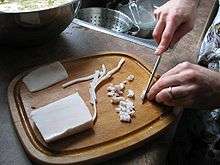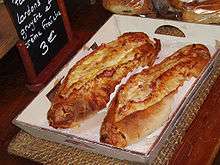Lardon
A lardon, also called lardoon or larding, is a small strip or cube of fatty bacon, or pork fat (usually subcutaneous fat) used in a wide variety of cuisines to flavor savory foods and salads. In French cuisine, lardons are also used for larding, by threading them with a needle into meats that are to be braised or roasted. Lardons are not normally smoked, and they are made from pork that has been cured with salt.

In French cuisine, lardons are served hot in salads and salad dressings, as well as on some tartes flambées, stews such as beef bourguignon, quiches such as quiche Lorraine, in omelettes, with potatoes, and for other dishes such as coq au vin.
The Oxford English Dictionary defines "lardon" as "one of the pieces of bacon or pork which are inserted in meat in the process of larding", giving primacy to that process.[1] According to the Middle English Dictionary, the earliest occurrence of the word is in 1381, in the work Pegge Cook; it advises to insert lardons in cranes and herons.[2]
Preparation
Lardons may be prepared from different cuts of pork, including pork belly and fatback, or from cured cuts such as bacon[3] or salt pork. According to food writer Regina Schrambling, when the lardon is salt-cured but not smoked in the style of American bacon, "the flavor comes through cleanly, more like ham but richer because the meat is from the belly of the pig, not the leg".[4] The meat (fat) is usually cut into small strips or cubes about one centimeter (3⁄8 inch) wide, then blanched or fried.
Some chefs recommend using pancetta as a substitute;[5] ham is also suggested.[6]
Usage


It is common for the lardons to be used for two distinct purposes in the same dish. The fat rendered from the cubed pork is good for sautéing vegetables or meat during the early stages of a recipe, and the crisp browned pork cubes can be added as a garnish or ingredient just before serving: "the crispy bits are used to add a smoky, salty flavor and a pleasant crunch to all kinds of dishes". The rich flavor pairs well with cheeses and sturdy leaf vegetables like spinach and frisée, for which the hot rendered fat can be used as part of the salad dressing.[7]
Lardons are frequently used in French cuisine to flavor salads, stews (such as beef bourguignon and Julia Child's coq au vin[8]), quiches (quiche Lorraine), potatoes, omelettes and other dishes.[9] A particular Parisian use of lardons is in the salade aux lardons, a wilted salad (often made with frisée (endive)[10] lettuce) in which the lettuce leaves are wilted slightly by the addition of still-hot lardons and hot vinaigrette.[11] A nineteenth-century recipe for a pie à la chasse calls for beef to be larded with lardons made of ham and bacon.[6] A traditional dish from the Alsace region is the tarte flambée, a thin pizza-like bread covered with crème fraiche, onion, and lardons.[12][13] A regional specialty from the Savoie is tartiflette, which is made with potatoes, reblochon cheese, cream, and lardons.[14]
Larding
.jpg)
A traditional use for lardons is in a technique called "larding", in which long strips of chilled pork fat are threaded (with the use of a needle) into meats that are to be braised or roasted, such as beef filets or veal (especially lean cuts[15]), poultry,[16] and lean fish such as salmon.[17][18] These lardons are to be cut in strips about 3 mm thick and 3 mm wide, and it is essential that the fat be chilled before cutting and threading. The technique is explained at length in the classic book of French cuisine La bonne cuisine de Madame E. Saint-Ange, which details two techniques: surface larding, or "studding", in which the lardons are threaded onto the surface, and interior larding, in which the lardons are left in a channel (made with a larger-sized needle than is used for studding) inside the meat.[19] Madame St. Ange recommends larding for braised calf's sweetbreads[20] (as does the French Laundry cookbook[21]) and for a specific style of cooking hare.[22] American food writer James Peterson specifically recommends using fatback for larding; salt pork, he says, "has a funny taste and won't work".[23] Julia Child recommends using lard or porkbellies (pancetta); she too thinks that neither salt pork nor bacon work, and suggests blanching these first, to get rid of the overwhelming cured or smoked flavors. The origin of larding is in the Middle Ages, when edible meat was sourced from hunting game and was often too lean and tough because of the animal's natural physical activity; larding provided the equivalent of today's marbling.
The needle used is a larding needle (also "barding needle" or lardoir).[23] There are two basic kinds of larding needle, hollow and U-shaped. Hollow larding needles are about 5 mm in diameter with some sort of teeth or hook to keep the lard strip attached; they are passed completely through the meat. U-shaped larding needles, often called by the French name lardoir, are long needles with a "U" cross-section. Four larding needles, accompanied by two crossed turning spits, are found in the coat of arms of the Confrérie de la Chaîne des Rôtisseurs, a French gastronomic society.[24]
In other cuisines
In many cuisines around the world, pork fat is used as a flavoring, and lardons are found in various other cultures. In Puerto Rico, they are called tocino and are added to dishes such as arroz con gandules. Lardon is simular to the easter european salo.
References
- "Lardon". Oxford English Dictionary. 1987.
- Lewis, Robert E.; Kurath, Hans (1970). "Lardon". Middle English Dictionary, L.2. 7. U of Michigan P. p. 657. ISBN 978-0-472-01122-3. Retrieved 26 February 2010.
- von Starkloff Rombauer, Irma; Marion Rombauer Becker; Ethan Becker; Maria Guarnaschelli (1997). Joy of cooking. Simon and Schuster. p. 705. ISBN 978-0-684-81870-2. Retrieved 25 February 2010.
- Schrambling, Regina (2005-03-16). "The taste of bacon, cubed". Los Angeles Times. ISSN 0458-3035. Retrieved 2019-06-28.
- Schrambling, Regina (16 March 2005). "The taste of bacon, cubed". Los Angeles Times. Retrieved 25 February 2010.
- Dolby, Richard (1833). The cook's dictionary, and housekeeper's directory. H. Colburn & R. Bentley. p. 55. Retrieved 26 February 2010.
- Diluna, Amy (14 July 2002). "Special Ingredient: Lardon". New York Daily News. Archived from the original on 4 June 2011. Retrieved 26 February 2010.
- "Lardons: Chef's secret ingredient". Sacramento Bee. 28 November 2007. pp. F3. Retrieved 25 February 2010.
- Worthington, Diane Rossen (2003). French. Pan Macmillan. p. 37. ISBN 978-1-4050-3558-3.
- Lomonaco, Michael; Andrew Friedman (2004). Nightly Specials: 125 Recipes for Spontaneous, Creative Cooking at Home. HarperCollins. p. 15. ISBN 978-0-06-055562-7. Retrieved 26 February 2010.
- Peterson, James (2002). "Green Salad with Bacon (Salade aux Lardons)". Glorious French food: a fresh approach to the classics. John Wiley and Sons. pp. 52–53. ISBN 978-0-471-44276-9.
- Villegas, Maria (2005). "Tarte flambée". The food of France: a journey for food lovers. Murdoch Books. p. 56. ISBN 978-1-74045-471-1. Retrieved 26 February 2010.
tarte flambee.
- Schuffenecker, Gérard; Alain Kauffmann (1997). "La tarte flambée; Flammekueche". Connaître la cuisine alsacienne (in French). Editions Jean-Paul Gisserot. pp. 32–33. ISBN 978-2-87747-286-9. Retrieved 26 February 2010.
- Willan, Anne (2007). "Tartiflette: Potato and Reblochon Cheese Melt". The Country Cooking of France. Chronicle Books. p. 60. ISBN 978-0-8118-4646-2. Retrieved 26 February 2010.
- Riely, Elizabeth (2003). The chef's companion: a culinary dictionary. John Wiley and Sons. p. 165. ISBN 978-0-471-39842-4. Retrieved 26 February 2010.
- Dolby 474.
- Willan 60.
- Ellis, Merle (12 May 1982). "Old-fashioned needle eyes beef trend". Reading Eagle. p. 27. Retrieved 26 February 2010.
- Ébrard, Evelyn (2005). La bonne cuisine de Madame E. Saint-Ange: the original companion for French home cooking. Paul Aratow (trans.). Ten Speed Press. pp. 11–13. ISBN 978-1-58008-605-9. Retrieved 25 February 2010.
- Ébrard 303.
- Keller, Thomas; Susie Heller; Michael Ruhlman; Deborah Jones. The French Laundry cookbook. Artisan Books. p. 213. ISBN 978-1-57965-126-8. Retrieved 26 February 2010.
- Ébrard 416.
- Peterson 523.
- "History of the Chaîne des Rôtisseurs". Confrérie de la Chaîne des Rôtisseurs. Retrieved 25 February 2010.
External links
| Look up larding in Wiktionary, the free dictionary. |
| Wikimedia Commons has media related to Lardon. |
.jpg)